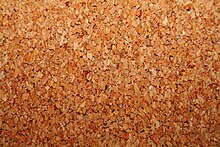
Back Zuro AN فلين Arabic Корк Bulgarian Pluta BS Suro Catalan Korek Czech Kork Danish Kork German Φελλός Greek Korko Esperanto

Cork is an impermeable buoyant material. It is the phellem layer of bark tissue which is harvested for commercial use primarily from Quercus suber (the cork oak), which is native to southwest Europe and northwest Africa. Cork is composed of suberin, a hydrophobic substance. Because of its impermeable, buoyant, elastic, and fire retardant properties, it is used in a variety of products, the most common of which is wine stoppers.
The montado landscape of Portugal produces approximately half of the cork harvested annually worldwide, with Corticeira Amorim being the leading company in the industry.[1] Cork was examined microscopically by Robert Hooke, which led to his discovery and naming of the cell.[2]
Cork composition varies depending on geographic origin, climate and soil conditions, genetic origin, tree dimensions, age (virgin or reproduction), and growth conditions. However, in general, cork is made up of suberin (average of about 40%), lignin (22%), polysaccharides (cellulose and hemicellulose) (18%), extractables (15%) and others.[3]
- ^ Calheiros, J. L.; Meneses, E. "The cork industry in Portugal". Junta Nacional da Cortiça, Portugal. Archived from the original on 12 January 2012.
- ^ "Robert Hooke (1635-1703)". UC Museum of Paleontology @ UC Berkeley. Retrieved 10 December 2022.
- ^ Duarte, Ana Paula; Bordado, João Carlos (2015). "Cork – A Renewable Raw Material: Forecast of Industrial Potential and Development Priorities". Frontiers in Materials. 2: 2. Bibcode:2015FrMat...2....2D. doi:10.3389/fmats.2015.00002. ISSN 2296-8016.
 Text was copied from this source, which is available under a Creative Commons Attribution 4.0 International License.
Text was copied from this source, which is available under a Creative Commons Attribution 4.0 International License.